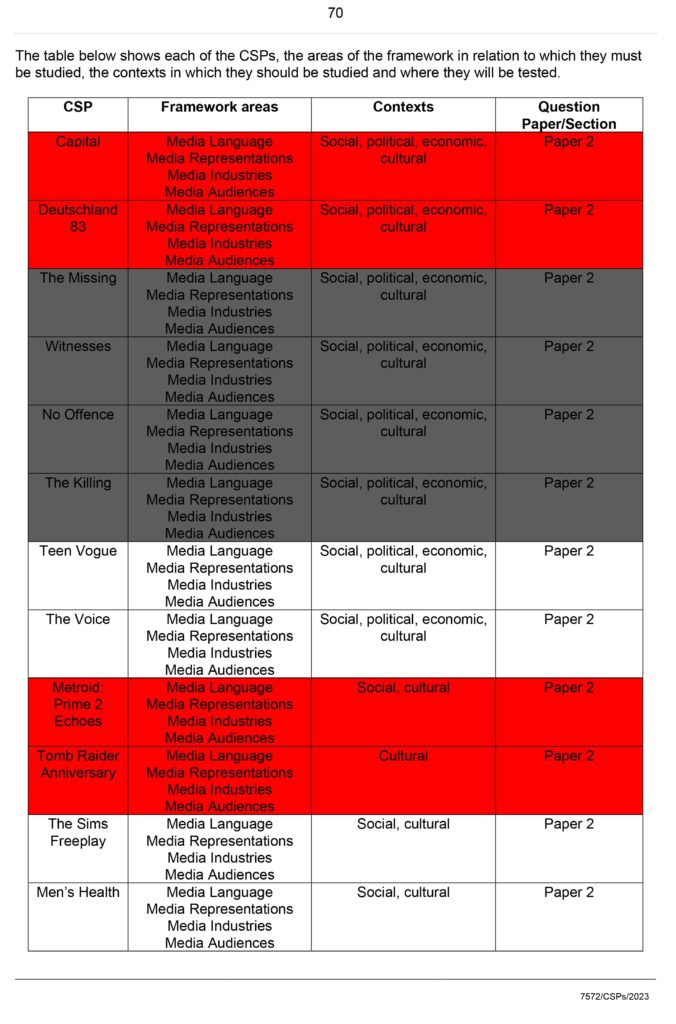Command Words
Describe – Provide a detailed account of something in words
Compare – Estimate, measure, or note the similarity or dissimilarity between
Evaluate – Form an idea of the amount, number, or value of; assess
Analyse – Similar to evaluate, except in detail and to interpret it
Knowledge – Acquiring skills or information through education or experience
Understanding – Being able to apply and connect your knowledge
| What do I know? | What do I understand?/What does my knowledge mean? | |
| Noam Chomsky | Wrote a book called ‘Manufacturing Consent’ People in power e.g. the Government have a large amount of control over the media. 5 filters of mass media; Ownership, advertising, official sources, flak, common enemy | |
| James Curran | Studied the early 1800s era of media distribution, and described how newspapers were only producible by people with the wealth to manufacture products on an industrial scale. | |
| Jean Seaton | ||
| Jurgan Habermas | Came up with the ideology of the Public Sphere, a realm of human social life in which a public opinion can be formed. Habermas states that all citizens have access to the Public Sphere. | The introduction of the printing press The rise of the Internet has brought about a resurgence of scholars applying theories of the public sphere to Internet technologies. |
| David Gauntlet | ||
| Judith Butler | ||
| Laura Mulvey | ||
| Paul Gilroy | ||
| Edward Said | ||
| David Hesmondhalgh | ||
| Thomas Shatz | ||
| Ferdinand de Saussure | ||
| C S Pierce | Iconic sign – The bold text tells you what you can find inside of this magazine issue. It all relates to loosing weight fast Indexical signs – The only image is the dominant signifier placed right in the middle. The muscles relates to the text and the magazine. Symbolic sign – The magazines colour theme is mostly blue which is seen as a stereotypical colour for men, influences them to buy the magazine. Big bold texts all about loosing weight “demolish junk food cravings” and “Blast body fat”. The dominant signifier, vin diesel, is positioned in the middle showing off his muscles. | |
| Semiotics | ||
| Representation | ||
| Audience | ||
| Feminist Critical Thinking | ||
| Postcolonialism | ||
| Narrative Theory | Todorov, Freytag, Propp, Levi-Strauss, Chatman, Barthes | Todorov – He discovered that narratives moved forward in a chronological order with one action following after another. In other words, they have a clear beginning, middle and end. Stock Characters: Hero Helper Princess Villain Victim Dispatcher Father False Freytag – |
| Genre | Steve Neal, a subject’s genre can be determined by a series of repeated events. Genres can be combined to create hybrids. | |
| Key Terms for Industry and Business | Vertical/Horizontal integration Mergers Monopolies Conglomerate Risk and Reward Concentration of Ownership Authoritarian/Libertarian Political Compass Regulation and Control Risky Business | |
| Public Service Broadcast (PSB) | Television and Radio programmes that are broadcast to provide information, advice, or entertainment to the public without trying to make a profit: The channel is trying to reduce its obligations to produce public service broadcasting such as religious programmes. BBC Channel 4 Ideas of the Liberal Free Press Chomsky Habermas Curran and Seaton Livingstone and Lunt | |
| Lasswell | Best known for his model of communication, developed in the 1920s and 1930s. Who says What to Whom in What Channel with What Effect Linear communication theory Passive audience No individual audience | Connects with Steve Neale’s theory of genre and the repertoire of elements to create an atmosphere. Hypodermic Model/Theory/Needle |
| Lazerfeld | He established the two lenses of analysis, being Research Institutes and Methodology. Two-step flow Opinion leaders | |
| Uses and Gratifications | Bulmer and Katz developed a theory stating that users have an active role in choosing and using the media. The user searches for a source of media that fulfils their personal needs. There are 5 reasons for this: – Information and Education – Entertainment – Personal Identity – Integration and social interaction – Escapism | |
| Stuart Hall | He stated that representation is the ability to describe and imagine. He provides two views on cultural identities. These are an individual shared culture and similarities amongst a group of people, and the second includes both similarities and differences amongst a group of people Framework provided for decoding messages: Accept the dominant message Negotiate the dominant message Reject the dominant message | |
| George Gerbner | Founder of the cultivation theory. This suggests that exposure to media affects a viewer’s perceptions of reality, drawing attention to three aspects: institutions, messages, and publics. |


